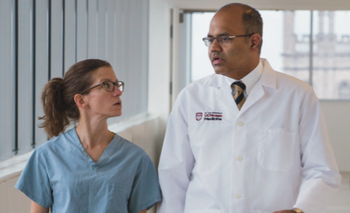
There is no difference in treatment for non-secretory multiple myeloma and multiple myeloma, an expert told CURE®.

There is no difference in treatment for non-secretory multiple myeloma and multiple myeloma, an expert told CURE®.

New tools help manage ESR1 mutations in metastatic breast cancer.

Recent developments in PARP inhibitor combinations and antibody-drug-conjugates are changing the landscape of ovarian cancer treatment.

Anti-TIGIT immunotherapy drugs may improve quality of life and survival, while being well tolerated by patients.

Recent research has demonstrated the ability of immunotherapy combinations to target advanced melanoma.

An oncologist from Fox Chase Cancer Center in Philadelphia explains the early career mentorship that inspired his successful lung cancer career.

Not having known much about lung cancer, a woman describes her shock at receiving a diagnosis despite being a non-smoker.

A lung cancer doctor explains how he got lucky to fill in a role in the lung cancer space, and his career and passion took off from there.

Targeted therapies offer new hope for patients with HER2-mutated non-small cell lung cancers.

Caregivers of patients with cancer may face financial toxicity and stress — with little time to take care of themselves.

For some cancer survivors, eating and drinking can become difficult, if not impossible, after treatment.

Postponing tests or doctor visits during the pandemic may increase women’s risk of cancer.

Weighing the cost of CAR-T cell therapy in treating blood cancers is a finical burden for many patients with blood cancer.

Often uncovered by accident, appendiceal cancers trigger few symptoms until they’re advanced and can be difficult to detect and treat.

Cancer-related cognitive dysfunction affects many survivors. But the right strategies can optimize thinking and memory — and help lift that fog.

Symptoms that mimic fibroids make diagnosing uterine sarcoma a rare and confounding cancer.

Cancer and its treatments rob the immune system of power, so it’s imperative that patients get the flu vaccine to stave off illness.

A variety of minimally invasive techniques can remove genitourinary tumors.

Two husbands embrace changing and challenging roles at home when they learn of their spouses’ cancer diagnoses.

Understanding federal and state laws can protect workers who have cancer.

Exercise and acupuncture use the body’s physiology to relieve joint pain caused by hormonal treatments after breast cancer.

Physical therapy can boost quality of life for patients with cancer, but it isn’t always prescribed.

New targeted therapies are rapidly changing the landscape of non-small cell lung cancer.

Cancer during pregnancy challenges the entire family.

Women diagnosed with cancer while pregnant can undergo treatment that is tailored to protect their babies’ safety.

New therapies are emerging for the treatment of cholangiocarcinoma, a rare type of cancer that is not often discussed.

Opioids have their place in treating cancer pain, but care must be taken to avoid addiction.

Coping with body changes can be difficult for survivors to accept.

Patients often face challenges in adhering to infused chemotherapy or radiation, but many obstacles can be resolved.

Evolving strategies for the elimination of nausea and vomiting are making treatment more comfortable for many patients with cancer.

Published: September 23rd 2020 | Updated:

Published: November 22nd 2021 | Updated:

Published: March 16th 2022 | Updated:

Published: December 18th 2023 | Updated:

Published: April 13th 2022 | Updated:

Published: July 8th 2021 | Updated: